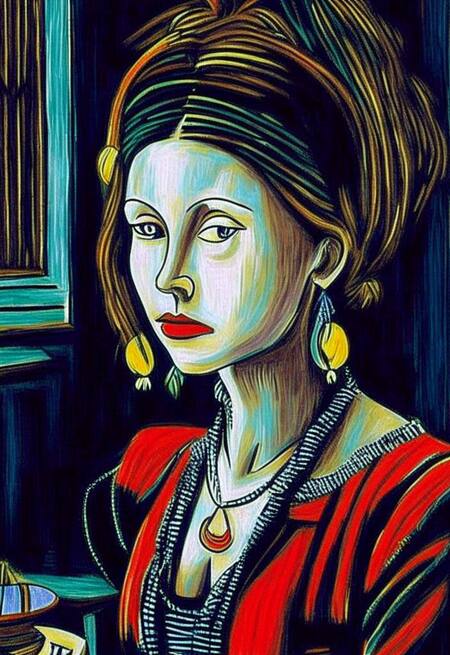
Daria Saltykova: «a freak of the human race» and the first Russian serial
100 years before the legendary Jack the Ripper, who almost frolicked into a terrible fairy tale, and his Russian and less folk counterpart Nikolai Radkevich, Daria Nikolaevna Saltykova lived in a mansion on Kuznetsky Most. With such a respected name and the enviable inheritance she received, she could be a woman of the easiest fate, but no. For 6 years, she tortured to death at least 38 and at most 138 serfs, which earned her life imprisonment in an earthen pit, the sign «torturer and murderer» and bloody glory through the ages. Everything is the way we like: not only about wild cruelty, sophisticated violence, bribery and anguish, but also about love, jealousy and charitable deeds.
It is typical for schizophrenia to flourish at puberty, but Daria Nikolaevna Saltykova (aka Saltychikha aka Cannibal) is a surprising exception. Until the age of 26, she managed to live an almost imperceptible life, despite the fact that she was the heiress of several noble families from pillar nobles, which means «old» money, a good upbringing, blue blood, all that. Her grandfather Avtonom Ivanov, under Peter I, was responsible for the distribution of land allotments and saved up quite a lot — even Hetman Mazepa turned to him for patronage. Daria married the captain of the Life Guards Cavalry Regiment Gleb Saltykov, whose family was distantly related to the reigning Romanovs. In 1750 and 1751, two sons were born in a row — Fedor and Nikolai, who later also served in the guards regiments. Despite the fact that real estate, souls, land and money were plentiful, we do not observe any mention of cool revels, impulsive purchases and heart-rending consumerism. «A blooming, pious woman, ” they said about her. Indeed, Daria considered it important to check in to holy places: she went on pilgrimage, even reached the Kiev-Pechersk Lavra, generously donated to churches and distributed alms.
And so Daria Nikolaevna would have remained a meager Wikipedia article that no one reads, if not for the death of her husband, after which everything changes dramatically. And just as I admire the fact that Arthur Rimbaud wrote all his poems before the age of 19, the scale of animal cruelty that Saltykova fit into just 6 years is also striking. Looking back 300 years, apparently the death of her husband was the trigger.
So, having been widowed around 1756, she united in her hands four large fortunes of rich and influential families in Moscow: the Ivanovs, the Skripitsins, the Davydovs and the Saltykovs. She is one of the richest female widows in Moscow: about 600 souls (and this can be immediately multiplied by 1.5, because neither women nor children were considered «souls» then) on the estates of the Moscow, Vologda and Kostroma provinces, a solid state, all the Upper Teply Stans, the village of Krasnoe-on-Pakhra with all its environs and small villages, possessions in Moscow from Bolshaya Lubyanka to Kuznetsky Most with a three-story city estate, numerous estates in the Kostroma province, in particular, Ploskovo, Filikha, Shubikha, Belyshikha, Mikhalikha and Savikha. And of course, the pearl, top of the top, cream of the cream — the estate where Saltychikha most often tortured and killed — Troitskoye. This is the closest suburb of Moscow, right near the Moscow Ring Road against the Tyoply Stan district, where the village of Mosrentgen is now located. I have a special fondness for this place, because it is the closest «village with a shop» to my dacha, where I spent all my childhood and a signifi
Troitskoye estate nowadays Source: https://vadimrazumov.ru/28388.html
With all this and a life ahead, rich and young (she is 26) woman begins to kill. And what distinguishes her from all the serials that I know, she does it like a little girl who demands something, not knowing what — not hiding at all, obviously in a temper, not noticing anything around, stamping her foot in the rapture of her own hysteria. Obviously, the general and absolute unbridledness and impunity in relation to serfs plays a role here, but the fact that a woman tortures women is some kind of exception to the exceptions.
What did Daria Saltykova do in her free time except for business? And she was a diligent housewife, which will ruin her. About six months after the death of her husband, she began to methodically beat her servants — mostly with logs. Non-critical punctures, such as an untimely smile or supposedly unfair performance of duties — poorly washed floor or dress — began to provoke torture, which over time became longer and harder.
How she tortured and killed: - beat with a rolling pin / log / iron - doused with boiling water - singed hair and face - grabbed hair with hot curling irons and dragged by the ears - dragged hair and pulled it out - banged head against the wall - starved - tied naked in the cold - driven naked into the pond in autumn - ordered to whip hard
Illustration of the work of V. N. Kurdyumov for the encyclopedic edition «Great Reform»
There are no historically confirmed portraits of Saltykova left. What is usually passed off as them are portraits of her namesake, Countess Daria Petrovna Saltykova. But apparently, in her youth she was quite conventionally beautiful, and the list of «hobbies» hints that Saltykova was a fairly strong woman. Carrying someone around, beating and pulling out hair is not for bird girls. There is no evidence of cannibalism and boiled babies, which you can read about somewhere — zero mystical overtones. The very essence of her torture is not to mutilate in order to be more beautiful than everyone else, but to hurt, get rid of, kill. Perhaps that is why some researchers talk about a hidden lesbian subtext. Although we know little about her husband, about how he died (like from a simple cold) and whether he had dirty stories with serf girls (pffff, master and serfs — why would), after which Saltykova discovered in herself such terrifying talents.
But a story that we know for sure speaks against the version of latent homosexuality: land surveyor Nikolai Tyutchev. It is known for certain that on the territory of Saltykova he measured not only the land — for quite a long time they were lovers. According to legend, Saltychikha was informed that someone was jackaling on her territory — measuring and writing down something — she became furious, ordered to grab and bring the man, but after the meeting, which was quite stressful for Tyutchev, because nobody standed on ceremony with him, she was fascinated, fell in love and he stayed in her estate. But despite the money and influence of Saltykova, as his wife Tyutchev chose, to put it mildly, a poor girl (like 60 serfs) Pelageya Panyutina from a family that owned a small village neighbouring Saltychikha. Tyutchev knew firsthand about the character of Daria, so there was no talk of a civilized expense, but nevertheless in 1762 they parted. Saltykova was furious, but in general, she can be understood: he lived with her, slept with her, and then suddenly starred with a poor, but younger neighbour.
Nikolai Tyutchev
Anyone would be surprised in her place, but, of course, not everyone will send their serfs to buy gunpowder and sulfur, collect a bomb and order to blow up the house of the «young». Only the piety or kindness (who knows) of the peasants saved Tyutchev and Panyutina: they really chose to be downtrodden by the mistress than to take a sin on their souls — and returned to the mistress with a confession that they could not fulfill the order. Both were severely beaten with batogs (thick sticks for corporal punishment). After the wedding, the parents give Panyutina the Ovstug estate in the Bryansk district, and the young people decided to quickly dump there. Saltykova finds out about this and orders an ambush on the Old Kaluga Road (approximately the modern Kaluga Highway) and finally deal with them, but one of the peasants again shows himself heroically and warns them, thanks to which Tyutchev and Panyutina successfully get to the place where they spend a large part of life.
It is interesting that after Saltykova is arrested, Nikolai Tyutchev will buy the Troitskoye estate, where in 50 years his grandson and part-time poet Fyodor Ivanovich Tyutchev will read Virgil, Horace, blablabla,
But this is still far away, but for now, Troitskoye is a branch of hell, and the living conditions in it are inhuman: people are beaten and totally intimidated. By the way, I don’t understand how Saltykova was not afraid that her peasants would bang her, but apparently this is a blissfully forgotten pattern of behavior, within which the landowner has some kind of initial, unjustified respect and power, and the peasant completely perceives himself as property without desires, rights, the ability to live their own life. If it seemed to you that the tortures listed above were not so terrible, then be calm: Daria Saltykova brought them to extremes. If she beat, then to a frenzy — so that a person did not always have time to talk with a priest before his death, a newborn child died on the chest of his dead mother, there was a peasant who had three wives beaten to death in a row. In addition, she managed to organize a small criminal group: there were haiduks (kind of domestic killers) who did dirty things for her, there were several servants who covered everything, there was a priest in Troitskoye, who buried the downtrodden as if not noticing the traces of wild beatings.
In order to understand the degree of horror, you just need to know that with all the bottomless patience of the Russian peasants, 20 complaints were rolled over Saltykova in 6 years. But her position in society was determined not only by money, but also by extensive connections, and she methodically spent part of her fortune on generous bribes, thanks to which none of the complaints was given a go, and the «whiners» always returned to the «bloody mistress», after which disappeared without a trace or went into exile. It seemed that it was useless to fight. Already at the end of her bloody career, the headman of the village of Troitskoye, whose duties included organizing the funeral, could not stand it, and sent back to Moscow the mutilated corpse of another victim of Saltychikha, whom he was ordered to bury as having died of natural causes. The body ended up in the police station, it was examined — with all the bruises, fractures and injuries — and what would you think: they sent it back with an order to «bury».
A number of sources indicate that this was the last victim of the bloody mistress — the peasant woman Fekla Gerasimova. She allegedly did not cope well with household duties: the first time she was simply beaten, the second time became fatal. «Her hair was pulled out, her head was broken, and her back was rottening, ” — witnesses later said. Other researchers believe that Fekla Gerasimova, after being beaten and tortured, was buried immediately, even a little earlier than necessary — alive. Both versions are creepy. It was normal to beat a woman with a log for a poorly washed floor, pour boiling water over her face, drive her into a cold pond for half an hour, then force her to wash the floor again and when she could no longer stand, throw her into the canopy to die.
The 22nd complaint became fatal. Savely Martynov and Ermolai Ilyin, whose wives Saltychikha killed, reached St. Petersburg in 1762 and were able to directly convey the complaint to Catherine II, who had just ascended the throne. It was not easy — the fact that the testimony was not slander had yet to be proved, so the peasants were frightened at all levels — they were intimidated, starved, but nevertheless they handed over the case to the empress. This was the first high-profile case after the death of Peter III, and, coupled with the enlightened approach of the tsarina, it was the most important, now it would be called indicative. Catherine II had to articulate her position on violence against the serfs, to earn the love of the people without setting the nobility against herself. Luckily for her — it was an incredibly hypertrophied case. And she took a direct part in it. On October 1, 1762, the criminal case of the landowner Saltykova was accepted for consideration by the Moscow Justice Collegium.
The investigation into the case of Daria Saltykova lasted 6 years — the same amount of time she mocked her serfs. The case was handled by a specially appointed official, Stepan Volkov, and his assistant, court adviser Dmitry Tsitsianov. It is considered a big plus that they were not top-noble people so they were not included in the chain of bribes and did not have family ties with the suspect. They analyzed the account books, conducted large-scale searches and interviewed witnesses in Saltykova’s house in Moscow and in Troitsky. Having studied the records that Daria kept as accurately as possible, they found evidence of bribery of officials, including the head of the police office, the prosecutor of the Investigative Prikaz Fyodor Khvoshchinsky, the secretary of the Secret Office Ivan Yarov, the actuary of the Detective Prikaz Ivan Pafnutiev and others, as well as the most suspicious records about the movements of serfs souls, in which it was noted which peasants died, who was sold, who was sent to work or to other estates. According to them, 50 people were considered «dead from diseases», 72 people were «missing without a trace», 16 — «sent to husband» or «gone on the run».
Stepan Volkov (the best name for a cop, imho — practically Steppenwolf) and Dmitry Tsitsianov started a flurry of activity and interviews of witnesses in Saltykova’s house on Sretenka, in Troitskoye and the surrounding area — they talked to more than 300 people. It was not only long, but also exhausting work: it was impossible to be sure of anything, because many told about the wild antics of Saltychikha «from the words» of acquaintances, some of the serfs were themselves involved in bloody deeds, so they completely denied everything and some, as usual, were settling their scores. So out of 138 murders in which Daria was suspected, only 38 had witnesses and evidence, and in 11 cases she was acquitted. By the way, it is also interesting that the task of hanging too much was not set — significant trial in every sense.
Among the crimes, which were told by residents of neighboring houses and priests of the Vvedenskaya Church and the Church of John Belogradsky (both located in the immediate vicinity of Saltykova’s house), in particular, were: - the murder of a 12-year-old courtyard girl (presumably Praskovya Nikitina) through prolonged beatings; - the murder as a result of prolonged torture of 19-year-old Fekla Gerasimova (whose body was officially handed over to the 1st police team, where priests saw the deceased); - keeping serfs in shackles and logs (this was reported independently by four people who lived next door to Daria Saltykova’s house); - long-term maintenance of barefoot serfs in the winter in the snow (testimonies were given by nine witnesses); - prolonged corporal punishment of the servants, during which Saltykova personally commanded the torturers to «beat more!» (five witnesses).
However, 94 people during the general search on Sretenka stated that they knew nothing about the crimes of Daria Saltykova.
During all the years of the investigation, Saltychikha did not confess to a single crime, despite the priest, who was settled in her house for six months to make her talk about her sins, despite the intimidation of torture. It is interesting that, no matter how shocked Catherine II was by Saltykova’s approaches, she did not allow to torture her. Maybe years of Darya’s bribery played its part, or the need to maneuver between letting the nobility know that bestial cruelty towards serfs is no longer allowed, and not turning them against tsarina, so policemen could just cause sense of anxiety torturing another criminal in front of Saltykova and saying she would be next. Darya Nikolaevna was not very impressed by the show. Judging the nobles was so unacceptable that the senators, who voted for Saltykova’s guilt, nevertheless left the final decision to the queen. October 2, 1768 Catherine II approved the verdict. They say she rewrote it up to 8 times.
Virgilius Eriksen «Portrait of Catherine II in front of a mirror» 1762 — 1764
In the final version, Daria Saltykova was sentenced: - to deprivation of the title of nobility; - to a life-long ban on being called by the name of her or husband’s family, it was also forbidden to indicate her noble origin and family ties with other noble families; - to serving for an hour a special «reproachful spectacle», during which the convict was to stand on a scaffold chained to a pole with the inscription above her head «tormentor and murderer»; - to life imprisonment in an underground prison without light and human communication (light was allowed only during meals, and conversation was only with the head of the guard and a woman nun).
The sentence
The sentence was carried out on October 18, 1768. A scaffold was built on Red Square, poles with chains were placed on it, there she stood for an hour in front of a crowd of people with a sign «torturer and murderer», and the priest and several close serfs were carved and branded. She spent 33 years in the Moscow St. John the Baptist convent, the first 11 years — in a «repentant» dugout 2 meters high without light, then — in a stone annex in the church. According to legend, Daria Saltykova died immediately after meeting with Emelyan Pugachev, who came to her place of detention, and only 2 black crows flew to her funeral. She was buried at the Donskoy cemetery — her grave can still be found there.
Modern medical experts believe that Daria Saltykova suffered from a mental disorder called epileptoid psychopathy. This disease is characterized by outbreaks of unmotivated aggression and irritation, in this case turned into cruel and sophisticated murders, causeless gloomy mood, sadism — both in relation to animals and to people, inability to control anger even in cases where it poses a threat to life of the psychopath himself, low sexual activity, a tendency to hoarding, jealousy, reaching extreme forms. Also, many epileptoid psychopaths demonstrate their homosexuality through the humiliation and beating of sexually interesting objects.
List of victims, possible and proven (+)
Agrafena Potapova Aksinya Anna Vasilyeva Akulina Andreeva Agrafena Mikhailova Agrafena Alekseeva Irina Kharlamova
Groom Ilyin’s wives: Aksinya Yakovleva + Katerina Semenova Fedosya Artamonova
Fekla Germasimova + Khrisanf Andreev + Marya Petrova + Anisya Grigoryeva Stepanova + Anna Mikhailova Pelageya Petrova + Katerina Timofeeva Dementieva + Anna Petrova + Daria Dementieva + Lukyan Mikheev + Akulina Petrova + Stepanida Tarasova Shavkunova + Nikifor Grigoriev + Praskovya Rodionova + Feona Ivanova + Anna Filimonova + Mavra Isaeva + Praskovya Ivanova + Fekla Alekseeva + Nenila Mikheeva + Marina (Anna) Egorova + Marina Afanaseva Marina Fedorova Akulina Maksimova + Praskovya Larionova + Marya Alekseeva + Marya (surname unknown) + Praskovya Nikitina (12 years old) + Avdotya Artamonova + Avdotya Osipova + Pelageya Ivanova + Agafya Karpova Agafya (Agrafena) Nefedeva + Ustinya Filippova + Anna Matveeva + Katerina Ivanova + Elena Timofeeva + Anna Vasilyeva +
Anna Vasilyeva Afimya + Natalia Alekseeva + Irina + Marfa Timofeeva Avdotya Erofeeva Tatyana Antipova Lukerya Vasilyeva Nadezhda Vasilyeva Nastasya Gavrilova Agrafena Timofeeva Irina Alekseeva Anna Ivanova Praskovya Andreeva Agrafena Agafonova Akulina Agafonova Marya Fedorova
Groom Shavkunov’s wives: Ekaterina Ustinova, Natalya Prokofieva
Marya Mikhailova Akulina Vasilyeva Akulina Fyodorova Pelageya Vakulova Agafya Mikhailova Elena Vasilyeva Antonova (11 years old)
Sources:
https://pravo.ru/process/view/9237/
https://информа.рус/салтычиха/литература/студенкин-салтычиха/
https://kulturologia.ru/blogs/211216/32705/
http://www.istorya.ru/imagens/ludi/saltykova/prigovor1.jpg
http://www.istorya.ru/imagens/ludi/saltykova/prigovor2.jpg
http://murders.ru/Darya_Sal_1.html
https://ru.wikipedia.org/wiki/Салтыкова, _Дарья_Николаевна
https://ru.wikipedia.org/wiki/Тютчев, _Николай_Андреевич
Обложка: Kandinsky 2.2



